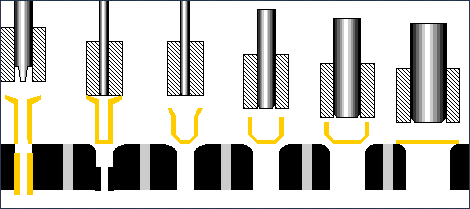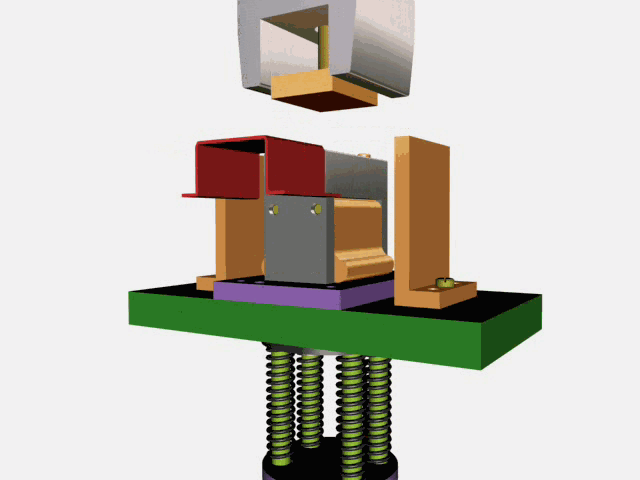
1. What is the function of the deep drawing sill (deep drawing rib) in the cover mold? The function of deep drawing bars is as follows:
1). Increase feed resistance to withstand sufficient tensile stress on the surface of the drawn part, improve the stiffness of the drawn part, and reduce defects such as concavity, distortion, relaxation, and ripple caused by rebound;
2). Adjust the flow of materials to ensure uniform flow resistance in all parts of the deep drawing process, or make the amount of material flowing into the mold suitable for the needs of various parts of the workpiece, to prevent the phenomenon of "more wrinkles, less cracks";
3). Expand the adjustment range of the edge pressing force. On a double action press, adjusting the height of the four corners of the outer slider can only roughly adjust the edge pressing force, and cannot fully control the feeding amount at each position to meet the needs of the workpiece. Therefore, it is necessary to rely on the edge pressing surface and deep drawing ribs to assist in controlling the pressure at each position;
4).When there are deep drawing ribs, it is possible to reduce the requirements for the machining roughness of the edge pressing surface, which reduces the manufacturing difficulty of large panel deep drawing dies; At the same time. Due to the presence of deep drawing ribs, the gap between the upper and lower edge pressing surfaces is increased, reducing the wear of the edge pressing surface and improving the service life of the mold;
5).Correcting material unevenness defects can eliminate the possibility of slippage. Because during the process of material flowing into the concave mold after generating undulations through the deep drawing ribs, it acts as a roller flattening effect.

2. What is the role of process cuts in large panels? When it is necessary to punch some deep local protrusions or bulges on the middle part of the covering part, in one deep drawing, the local fracture of the workpiece is often caused by the inability to obtain material supplementation from the outside of the blank. At this point, it is possible to consider punching process notches or process holes at appropriate positions in the local protrusion deformation zone, so that the easily fractured area can be supplemented with materials from within the deformation zone.
3. How to make a cutting process cut? There are two types of Stamping processing methods for process cuts:
1). This method of punching out during material cutting is used in situations where the local forming depth is shallow.
2). Cutting out during the deep drawing process is a commonly used method, which can fully utilize the plasticity of the material, that is, to use the radial extension of the material at the beginning of the deep drawing stage, and then cut out the process incision. By utilizing the tangential extension of the material, a larger forming depth can be achieved. When cutting process holes during deep drawing, the tearing process is often used, which does not completely separate the material. The waste from the cut can be removed together in the subsequent trimming process. Otherwise, it will be difficult to remove waste from the die.
4. What are the principles for arranging process cuts? The size and shape of the process incision should depend on the area it is located in and the requirements for adding materials to the outside. Generally, the following principles need to be followed:
1). The incision should be adapted to the shape and contour of the local protrusion to enable the material to flow reasonably.
2). There should be sufficient overlap between the incisions to tighten the material of the convex die, ensure clear forming, and avoid defects such as ripples. This can ensure that good quality of the flange hole edge can be obtained after trimming.
3). The cutting part of the incision (i.e. the opening) should be adjacent to the edge of the protrusion or the area that is prone to rupture.
4) . The number of incisions should ensure that the material deformation at each protruding part tends to be uniform, otherwise it may not necessarily prevent the formation of wrinkles. As shown in the figure below, the original design only had two process cuts on the left and right, but cracks still appeared in the middle. Later, a middle cut (as shown by the dashed line) was added to completely eliminate the phenomenon of cracking.
5. In which Stamping production must precision progressive dies be used? In large-scale stamping production, small and medium-sized stamping parts with thin materials and high precision must use multi station precision progressive dies. For larger stamping parts, it is suitable for stamping processing of multi station transfer type molds.

6. What are the requirements for vulnerable parts in precision molds? Precision molds have complex structures, high manufacturing technology requirements, and relatively high costs. In order to ensure a high service life of the entire mold, it is particularly required that the mold parts be replaced quickly, conveniently, and reliably after damage or wear. Therefore, it is required that the important parts of the mold have interchangeability. This type of mold part with interchangeability can be called an interchangeability punch mold.
7. What is the significance of the layout design of precision progressive molds? Reasonable layout design can make the processing of each workstation of the mold coordinated and consistent, greatly improve material utilization, manufacturing accuracy, productivity, and mold life, and also reduce the difficulty of mold manufacturing. Therefore, layout design is the most critical comprehensive technical problem in precision progressive die design. It is necessary to comprehensively analyze and judge the stamping direction, deformation frequency, corresponding deformation degree, and the possibility of mold structure and processing technology of the parts in order to make the layout more reasonable.
8. What is a carrier? During the operation of a progressive die, the object that carries the billet to various workstations for various punching and forming processes is called a carrier. The part where the carrier is connected to the blank is called the lap, and the part where the blank is connected to the blank is called the lap. During dynamic machining, it is required that the carrier always maintains stable feeding and accurate positioning, therefore requiring the carrier to have a certain strength.
9. What are the requirements for the mold seat of precision progressive molds? M precision progressive die requires high strength, good rigidity, and high precision of the mold. Therefore, structural steel is usually used as the mold base, and its thickness is required to be thicker than the standard mold base. The upper mold base should be thickened by 5-10mm, and the lower mold base should be thickened by 10-15mm.
10. What are the types of concave mold structures? The commonly used types of concave die structures are integral. Block type and embedded type three blocks, standard concave templates are often used as integral concave molds in ordinary punching molds, and block type and embedded concave molds are often used in precision grade molds.
